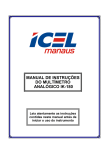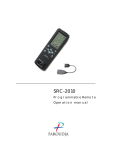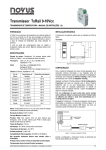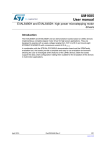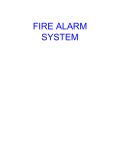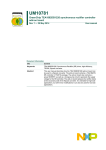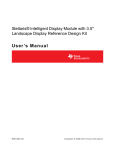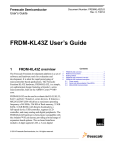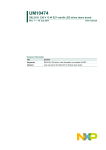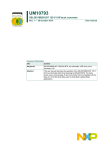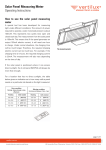Download Using the HT45FH3T for Active 3D Glasses
Transcript
Using the HT45FH3T in the Active 3D Glasses Using the HT45FH3T for Active 3D Glasses D/N: HA0315E Introduction With the continuous development of people’s living standards, the requirements for audio-visual entertainment is increasing, thus more and more 3D videos, movies and games are being produced and along with this is the rising demand for 3D glasses. A new 3D technology, a combination of active shutter 3D technology and active shutter 3D glasses, is widely used in TV and projector applications and provides good imaging effects. The Holtek HT45FH3T is especially designed for active 3D glasses development and this application sets out to show how it is used in such applications. 3D Glasses Functions The main function of 3D glasses is to receive and decode the IR signals from the TV for 3D glasses control. Due to the high voltage driving requirement, a boost circuit is needed to increase the battery voltage to 10V~12V for 3D glasses driving. A pair of 3D glasses contains two lenses each for the left eye and right eye. As each lens needs two high driving voltages, thus four high driving voltages are needed. So each 3D glasses circuit contains four level shift circuits, which are used to increase the 3V MCU I/O output voltage to 10V~12V for the 3D glasses on/off control. In addition, each pair of 3D glasses needs an IR receiver circuit to receive external IR signals. 3D glasses normally use a battery power supply, which can be divided into two types. The first type is a chargeable lithium battery and the second type is a non-chargeable button battery. An additional lithium battery charging circuit is required when using the lithium battery. 1 Using the HT45FH3T in the Active 3D Glasses 3D Glasses Block Diagram 5V Charger IC USB I/P Booster 10~12V + ANx PWM VCC1 V12 TP0_1 AX HT45FH3T IR Receiver BX CX LCD Panel x2 DX HT45FH3T 3D Glasses Block Diagram Flash ROM 2K x 16 ADC RAM 128 x 8 CTM x 2 PTM LDO PTM I/O Level Shift HIRC 4MHz HT45FH3T Active 3D Glasses Main Features HT45FH3T Basic Features • • • • • • • • • • • • Note: Operating Voltage : 2.2V ~ 5.5V @4MHz System Clock : HIRC 4MHz Multi-mode operation : NORMAL, SLOW, IDLE and SLEEP Flash Program Memory : 2K×16 RAM Data Memory : 128 bytes 4-channel 12-bit ADC 10-bit CTM×2 10-bit PTM×1 -- provides PWM outputs 16-bit PTM×1 -- decodes IR input signals Over Voltage Protection function Level shift×4 3V LDO×1 1. The HT45FH3T system clock can be up to 4MHz. 2. The HT45FH3T-1 system clock can be up to 8MHz. 2 Using the HT45FH3T in the Active 3D Glasses HT45FH3T 3D Glasses Main Features • Uses lithium battery : 100mAh • Charging − Charging stand : USB Mini-B type ; input voltage : 5V − Use 100mA constant current for charging • • • • • Use 3-Line controlled LCD lenses Provides a battery charging indicator LED (Y) and a low voltage indicator LED (R) Provides a button for glasses on/off control Operating current: about 680µA Three-stage power saving mode − First stage power saving mode average current: 280µA − Second stage power saving mode average current: 180µA − Third stage power saving mode: self-power off • Use nVIDIA 3D VISION Protocol for IR Hardware Block Diagram Hardware Block Diagram 3 Using the HT45FH3T in the Active 3D Glasses Hardware Block Diagram Functional Description • Main control IC : HT45FH3T-1 -- system clock : 8MHz • Main USB charging port • • • • • • • • • • This port can be connected to a computer USB interface or an external power adapter for lithium battery charging. Charging IC Use 100mA constant current for lithium battery charging, during which the yellow LED lights up. Inductor Used to boost the battery voltage to the LCD lenses switch voltage. N-MOS Used for inductor booster control. Lithium battery A lithium battery with a capacity of 100mAh. Battery control circuit Used for the third stage power saving mode: self-power off. Button For user manual power on/off. LED indicator Used for low voltage indicating. Resistance divider Used for booster feedback control. IR receiver Receives the IR signals and converts them into digital signals. LCD lenses Works along with the IR signal for left and right lens on/off control. Hardware Circuit and Description Main Board Circuit 4 Using the HT45FH3T in the Active 3D Glasses IR Receiver Circuit The schematic is shown below: 15pF VDD 3M 200k - OPA + 15pF - 4.7nF OPA + 2k 7.15k 2k Amplify and filter the tiny current generated by the IR Photodiode CMP + Two signals input to the CMP - a digital signal is output to the MCU 5 330pF TO MCU Filter the amplified signal with a negative half cycle and add a base level Using the HT45FH3T in the Active 3D Glasses Circuit Description Battery Control Circuit The MCU can use PA1 to control the battery. When powered off, the user can press the button to turn on the power. When powered on, the MCU must keep PA1 high to ensure Q3 remains on. After the power is turned on, when the user press the button, the MCU will generate an external interrupt via INT1(PA6) and turn off the power via PA1. Charging IC Circuit Use an IN4054 for lithium battery charging. Setup R13 to be 10K so that a 100mA constant current can be used. OVP Function Settings Connect the OVP pin to the voltage dividing circuit which is output from the boost circuit. Setup the internal D/A reference voltage to come from VDD. Write a proper value to OVOREF[5:0] bits. When the boost circuit outputs a low voltage, the OUTH pin will automatically output a PWM signal to increase the boost voltage. 6 Using the HT45FH3T in the Active 3D Glasses Boost Circuit Use the BOOST_ON (MCU Pin 8, OUTH) PWM signal to control the Q1 on/off state. The energy stored in L1 is transferred and stored in C1 and C2, which together can generate a 10V boost voltage. A divided voltage generated using R6 and R7 is fed back to the MCU OVP function to maintain the boost out voltage at the correct level. LCD Lens Control The 3D glasses LCD lenses have 3-Line and 4-Line types. In this application, 3-Line controlled lenses are used. For the level shift circuits, whose power is supplied by the boost circuit, increase the LCD control voltage to 10V for the lens on/off control. Battery Voltage Detect Circuit Use the ADC to check the MCU internal band gap voltage, and select the ADC reference voltage to come from VDD. If the battery voltage falls below 3V, the VDD voltage will also fall below 3V. The band gap value detected at this moment will be higher than before, this indicating a VDD low voltage condition. LED used as a Low Voltage Indicator Main control MCU The main control MCU is the HT45FH3T-1, which has both integrated PWM and OVP circuits. IR Receiver Circuit In this circuit, tiny signals received by the IR photodiode will be filtered, amplified and integrated to generate the digital signals that can be processed by the MCU. 7 Using the HT45FH3T in the Active 3D Glasses IR Signals and LCD Lens Control Description Different 3D videos may generate different control signals, some IR signals have carrier signals while some signals are carrier-free. This application uses an nVIDIA protocol working together with IR signals with no carrier to implement decode operation and control the LCD lenses. Note that LCD lenses must be properly controlled to avoid the liquid crystals remaining at the same voltage level for too long to avoid damage. Basically, during a COM cycle, the positive level time and the negative level time are same for the same lens. This demo board uses 3-Line control mode, the liquid crystal level control and left/right lens control is shown below. 8 Using the HT45FH3T in the Active 3D Glasses PCB Layout Main Board Front Back 9 Using the HT45FH3T in the Active 3D Glasses Receiver Board 10 Using the HT45FH3T in the Active 3D Glasses HT45FH3T 3D Glasses Demo Board – BOM Table Type MCU Charging IC LDO Capacitor Resistor LED Inductor N-MOSFET P-MOSFE Diode Button Connector USB connector TVS Main Board Symbol Value Package Number U1 HT45FH3T-1 SSOP16 1 U2 IN4054 SOT23-5 1 U3 HT7830 SOT89 1 C9,C8 0.1uF 0603 2 C6 10uF 0805 1 C1,C2,C3,C4,C5 1uF 0603 5 R12 1K 0603 1 R14 1M 0603 1 R6 3.3M 0603 1 R13 10K 0603 1 R1 100 0603 1 R4,R2 100K 0603 2 R3 NC 0603 1 R7 360K 0603 1 R9,R10 470 0603 2 R11 470K 0603 1 D4,D5 Red, Yellow 0603 2 L1 100uH SMD 1 Q1,Q2 AO3400 SOT23 2 Q3 AO3401 SOT23 1 D1,D2,D3 BAT54 SOD232 3 SW1 SMD 1 J5 FPC-0.5mm-10pin 1 J6 MINI USB 1 D3 SOD323 IR Receiver Board 1 Type Symbol Value Package Number OPA Comparator Capacitor U1 U2 C4 C5,C6 C3 R4,R2 R6 R5 R1 D2 D1 OPA2348 LM7239 4.7nF 0.1uF 330pF 2K 3M 7.15K 200K BAT54 BPW 34 SOT23-8 SOT23-5 0402 0402 0402 0402 0402 0402 0402 SOD523 1 1 1 2 1 2 1 1 1 1 1 50 Resistor Diode Photodiode summary 11 Note Note Using the HT45FH3T in the Active 3D Glasses Software Flowchart Main Architecture Flowchart 12 Using the HT45FH3T in the Active 3D Glasses LCD Lenses Flowchart 13 Using the HT45FH3T in the Active 3D Glasses Demo Board Pictures Conclusions As the demand for 3D glasses products is increasing, the HT45FH3T can be used to reduce additional circuit requirements and PCB area, thus reducing production costs. 14
















